Verizon Plans to Introduce 5G Residential Broadband in 2018
December 4, 2017
In late 2018, Verizon Communications will begin to sell 5G home broadband services in three to five cities, first in Sacramento, California. All these cities are expected to be outside the Northeast U.S. region where it has a landline business and also offers its FiOS high-speed fiber-optic Internet service. To access the 5G signal, customers will have a box in their windows to convert it to Wi-Fi inside the house. If Verizon succeeds, it could compete in cities where most users have access to only one broadband provider.
The Wall Street Journal reports that, according to Leichtman Research, “Comcast Corp. is the country’s biggest broadband provider with about 25 million subscribers, followed by Charter Communications Inc. with about 23 million,” accounting for “almost half of all U.S. broadband connections.”
AT&T (which has almost 16 million broadband subscribers), Sprint, T-Mobile and Verizon (which has 7 million broadband customers) currently dominate the U.S. wireless industry. Most landline phone companies sell Internet over “copper-based services, such as DSL [which] deliver much slower Internet than cable.”
Verizon conducted home Internet trials in 11 markets, and AT&T has “active trials in several cities.” Webpass, acquired by Google, “also sells Internet using a similar model.” Among the challenges in 5G residential broadband is the so-called last mile problem. “Ripping up roadways and front lawns to install a wire to every home is expensive, and Verizon in recent years has sold off many of its wireline assets.”
Using wireless networks for home Internet requires companies to “install more antennas much closer to every house,” potentially on lamp posts. 5G signals are also “more fickle than current LTE technology,” and can “be disrupted by tree leaves or a large truck that parks in the driveway.” Wireless carriers in some rural areas “already use their existing wireless networks to sell home Internet, but it is expensive and the data plans resemble traditional wireless plans with strict data caps and sluggish speeds.”


No Comments Yet
You can be the first to comment!
Sorry, comments for this entry are closed at this time.